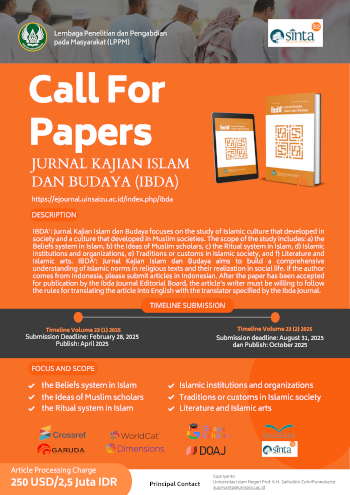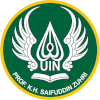Manakiban tradition of Sayyidah Khadijah al-Kubra at Mushalla Daruttaqwa Samarinda, East Borneo, Indonesia
DOI:
https://doi.org/10.24090/ibda.v21i2.9214Keywords:
manaqib, Sayyidah Khadijah, traditionAbstract
This paper examines the manaqib tradition of Umm al-Mu’minin, Sayyidah Khadijah al-Kubra in Mushalla Daruttaqwa, Sempaja, Samarinda. The tradition of occasionally reading manaqib has a historical context within the culture and psychology of the community and has produced definite behavioural changes in some or all aspects of the lives of those who engage in it. The manaqib tradition in Mushalla Daruttaqwa is held at ba’da maghrib on every 11th of the qamariyah month (Hijri year). This date is chosen as it coincides with the date of the death of Sayyidah Khadijah al-Kubra, namely on the 11th of Ramadan in the 10th year of the prophethood, three years before the Prophet’s migration to Yathrib (Medina). Sayyidah Khadijah died at the age of 65 when the Prophet was around 50 years old. This manaqib is conducted with sources that are in accordance with the guidance of Tuan Guru. The wisdom for the culture of our ancestors, provided it does not conflict with the texts of the Qur’an and Hadith, expects an abundance of blessings from Sayyidah Khadijah al-Kubra, including for people who love the auliya of Allah, especially the experts of the Prophet’s temple (ahl al-bayt). The activity also has elements and values of moral education, including as a forum for community gathering, as well as motivating children, in particular, to become part of the prosperity of violators and Islamic symbols.Downloads
References
Ahmad, F. (2020, May 14). 11 Ramadhan, mengenang wafatnya Sayyidah Khadijah. NU Online. https://islam.nu.or.id/sirah-nabawiyah/11-ramadhan-mengenang-wafatnya-siti-khadijah-Xhgvg
al-Aṣbaḥanī, A. N. A. ibn ’Abdillāh. (1405). Hilyah al-auliyā’ wa ṭabaqāt al- aṣfiyā’. Dār al-Kitāb al-’Arabī.
Ali, S. (2023). Refleksi moral diri dalam Manaqib Islam (Kajian historis Kitab Manaqib al-Busyra Karya Sayyid Muhammad ibn Alawi al-Maliki). Journal on Education, 5(4), 16501–16512. https://doi.org/10.31004/joe.v5i4.2813
al-Bukhārī, A. A. M. bin I. bin I. (2008). Ṣaḥīḥ al-Bukhārī. ῾Ibād al-Raḥmān.
al-Būṭī, M. S. R. (1996). Fiqh al-sīrah al-Nabawiyyah ma’a mūjaz li tārīkh al-Khilāfah al-Rāsyidah. Dār al-Fikr al-Mu’āṣir.
Hadi, A., Asrori, A., & Rusman, R. (2021). Penelitian kualitatif: Studi fenomenologi, case study, grounded theory, etnografi, biografi. Pena Persada.
Hanurawan, F. (2016). Metode penelitian kualitatif. Raja Grafindo Persada.
Herdiansyah, H. (2010). Metodologi penelitian kualitatif untuk ilmu-ilmu sosial. Salemba Humanika.
Jaharis, A. J. (2014, June 17). Qasidah ya wahibal ’athaya. https://blog.syafiqsharif.com/2014/06/qasidah-ya-wahibal-athaya.html
Jannah, M. (2019). Manaqib in the reception of the Banjar community: Sanctification of religious text. Dinika: Academic Journal of Islamic Studies, 3(3), 323–344. https://doi.org/10.22515/dinika.v3i3.1353
al-Kurdī, M. Ṭāhir. (1997). Tabarruk al-ṣahābah bi athari Rasūlillāh wa bayāni faḍlihi. Maktabah al-Qāhirah.
al-Malikī, al-S. M. A. (2002). Mafāhim yajibu an tuṣaḥḥah. Haiah al-Ṣafwah al-Malikiyyah.
al-Malikī, al-S. M. A. (2023). al-Bushrā fī manāqib Sayyidah Khadījah al-Kubrā. Diva Press.
Marwazi, M. (2021). Khadijah al Kubra: Peran perempuan agung dalam kehidupan. harakat An-Nisa: Jurnal Studi Gender dan Anak, 5(2), 59–64. https://doi.org/10.30631/harakatan-nisa.2020.52.59-64
Mawarni, N. I., Indriana, Y., & Masykur, A. M. (2010). Dinamika psikologis tafakur pada anggota Thariqah Qadiriyyah wa Naqsyabandiyyah di Pondok Pesantren Futuhiyyah, Mranggen, Demak. Jurnal Psikologi Undip, 3(2), 49–68. https://doi.org/10.14710/jpu.3.2.49-68
Mujiati, U., & Triyanto, A. (2017). Pengaruh lingkungan keluarga dan teman sebaya terhadap perilaku keberagamaan siswa di SMA Muhammadiyah 1 Kota Magelang. Jurnal Tarbiyatuna, 8(1), 69–82. https://journal.unimma.ac.id/index.php/tarbiyatuna/article/view/1761
Munirah, M. (2019). Pembacaan manaqib dalam tradisi masyarakat Banjar (Studi living Hadis). al-Risalah: Jurnal Ilmiah Keagamaan dan Kemasyarakatan, 15(2), 187–212. https://jurnal.stairakha-amuntai.ac.id/index.php/alris/article/view/65
al-Sijistānī, A. D. S. ibn al-A. (1998). Sunan Abī Dāwud. Muassasah al-Rayyān.
al-Sundī, S. ‘Abdullāh bin M. (2012). Majmū’at karāmah al-Sayyidah Khadījah al-Kubrā.
Ta’rifin, A. (2010). Tafsir budaya atas tradisi Barzanji dan Manakib. Jurnal Penelitian, 7(2), 1–14. https://doi.org/10.28918/jupe.v7i2.107
Taimiyyah, I. (2000). al-Risālah al-ṣafadiyyah. Dār al-Kutub al-’Ilmiyyah.
Downloads
Published
How to Cite
Issue
Section
License
Copyright (c) 2023 Muhammad Fajar Adyatama

This work is licensed under a Creative Commons Attribution-ShareAlike 4.0 International License.
Authors who publish with this journal agree to the following terms:
- Authors retain copyright and grant the journal right of first publication with the work simultaneously licensed under a Creative Commons Attribution-ShareAlike License a that allows others to share the work with an acknowledgement of the work's authorship and initial publication in this journal.
- Authors are able to enter into separate, additional contractual arrangements for the non-exclusive distribution of the journal's published version of the work (e.g., post it to an institutional repository or publish it in a book), with an acknowledgment of its initial publication in this journal.
- Authors are permitted and encouraged to post their work online (e.g., in institutional repositories or on their website) before and during the submission process, as it can lead to productive exchanges, as well as earlier and greater citation of published work (See The Effect of Open Access).















